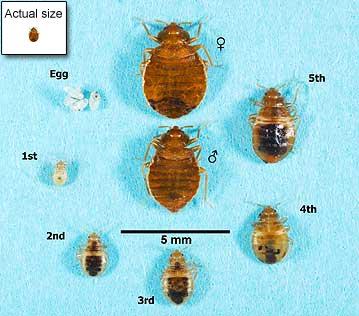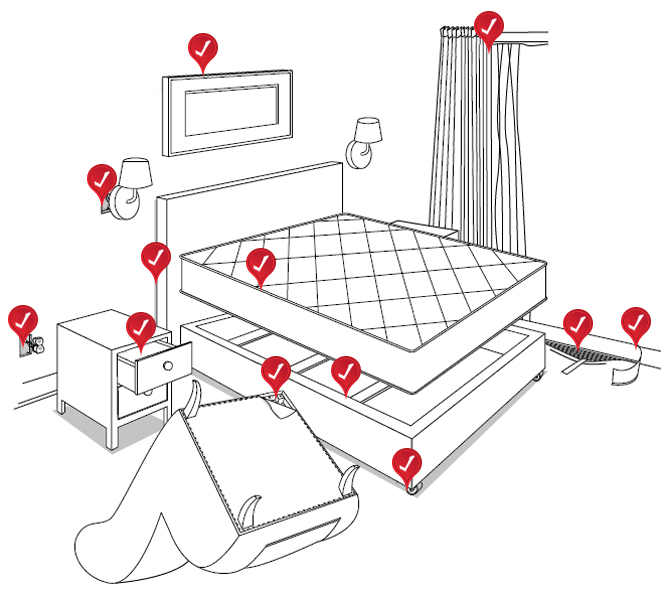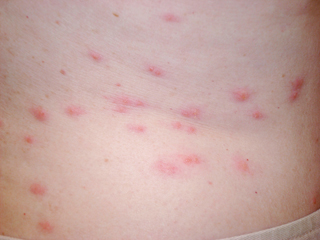Don’t let the Bedbugs bite
In this article we are going to cover a few points about bedbugs
- What are Bedbugs
- Where Bed Bugs Hide
- When Bedbugs Bite
- Signs of Infestation
- Bedbug Treatments
- Bedbug Extermination
What are Bedbugs?
 Bedbugs are small, oval, brownish insects that live on the blood of animals or humans. Adult bedbugs have flat bodies about the size of an apple seed. After feeding, however, their bodies swell and are a reddish color.
Bedbugs are small, oval, brownish insects that live on the blood of animals or humans. Adult bedbugs have flat bodies about the size of an apple seed. After feeding, however, their bodies swell and are a reddish color.
Bedbugs do not fly, but they can move quickly over floors, walls, and ceilings. Female bedbugs may lay hundreds of eggs over a lifetime, each of which is about the size of a speck of dust.
Immature bedbugs, called nymphs, shed their skins five times before reaching maturity and require a meal of blood before each shedding. Under favorable conditions the bugs can develop fully in as little as a month and produce three or more generations per year.
Although they’re a nuisance and cause undue psychological stress, they do not transmit diseases. Typically, no treatment is required for bedbug bites. If itching is severe, steroid creams or oral antihistamines may be used for symptom relief.
Where Bed Bugs Hide
 Bedbugs may enter your home undetected through luggage, clothing, used beds, couches and other items.
Bedbugs may enter your home undetected through luggage, clothing, used beds, couches and other items.
Their flattened bodies make it possible for them to fit into tiny spaces, about the width of a credit card. Bedbugs do not have nests like ants or bees, but tend to live in groups in hiding places. Their initial hiding places are typically in mattresses, box springs, bed frames and headboards where they have easy access to people to bite in the night.
However, over time… they may scatter through the bedroom, moving into an
y crevice or protected location. They may also spread to nearby rooms or apartments.
Because bedbugs live solely on blood, having them in your home is not a sign of dirtiness. You are as likely to find them in immaculate homes and hotel rooms as in filthy ones.
When Bedbugs Bite
 Bedbugs are active mainly at night and usually bite people while they are sleeping. They feed by piercing the skin and withdrawing blood through an elongated beak. The bugs feed from three to 10 minutes to become engorged and then crawl away unnoticed.
Bedbugs are active mainly at night and usually bite people while they are sleeping. They feed by piercing the skin and withdrawing blood through an elongated beak. The bugs feed from three to 10 minutes to become engorged and then crawl away unnoticed.
Most bedbug bites are painless at first, but later turn into itchy welts. Unlike fleabites that are mainly around the ankles, bedbug bites are on any area of skin exposed while sleeping. Also, the bites do not have a red spot in the center like flea bites do.
People who don’t realize they have a bedbug infestation may attribute the itching and welts to other causes, such as mosquitoes, heat rashes or allergic reactions. To confirm that what you have is bedbug bites, you must find and identify the bugs themselves.
Signs of Infestation
If you wake up with itchy areas you didn’t have when you went to sleep, you may have bedbugs, particularly if you got a used bed or other used furniture around the time the bites started. Other signs that you have bedbugs include:
- Blood stains on your sheets or pillowcases
- Dark or rusty spots of bedbug excrement on sheets and mattresses, bed clothes, and walls
- Bedbug fecal spots, egg shells, or shed skins in areas where bedbugs hide
- An offensive, musty odor from the bugs’ scent glands
If you suspect an infestation, remove all bedding linens and check it carefully for signs of the bugs or their excrement. Remove the dust cover over the bottom of the box springs and examine the seams in the wood framing. Peel back the fabric where it is stapled to the wood frame.
Also, check the area around the bed, including inside books, telephones or radios, the edge of the carpet, and even in electrical outlets. Check your closet, because bedbugs can attach to clothing. If you are uncertain about signs of bedbugs, call us and we can manage the infestation through a FRAUD PROOF exterminator, who will know what to look for and carry out a treatment plan.
If you recognize and find signs of an infestation, begin steps to get rid of the bugs and prevent their return immediately.
Bedbug Treatments
Getting rid of bedbugs begins with cleaning up the places where bedbugs live. This should include the following:
- Clean bedding, linens, curtains, and clothing in hot water and dry them on the highest dryer setting. Place stuffed animals, shoes, and other items that can’t be washed in the dryer and run on high for 30 minutes.
- Use a stiff brush to scrub mattress seams to remove bedbugs and their eggs before vacuuming.
- Vacuum your bed and surrounding area frequently. After vacuuming, immediately place the vacuum cleaner bag in a plastic bag and place in garbage can outdoors.
- Encase mattress and box springs with a tightly woven, zippered cover to keep bedbugs from entering or escaping. Bedbugs may live up to a year without feeding, so keep the cover on your mattress for at least a year to make sure all bugs in the mattress are dead.
- Repair cracks in plaster and glue down peeling wallpaper to get rid of places bedbugs can hide.
- Get rid of clutter around the bed.
- Of course we can look after all of this for you.
If your mattress is infested, you may want to get rid of it and get a new one, but take care to rid the rest of your home of bedbugs or they will infest your new mattress.
Bedbug Extermination
While cleaning up infested areas will be helpful in controlling bedbugs, getting rid of them usually requires chemical treatments. Because treating your bed and bedroom with insecticides can be harmful, it is important to use products that can be used safely in bedrooms. Do not treat mattresses and bedding unless the label specifically says you can use them on bedding.
Generally it is safest and most effective to hire a professional company with experienced in dealing with such issues. In Our Care – Home Care Services can help you from start to finish.
In Our Care – Home Care Services, understand that care is not simply based on the physical support your older loved one may need… there are a broad spectrum built-in service components to achieve our overall goal… Enriching the lives of those we love and deliver care to.
Your loved one may not be direct family, but they’re part of the In Our Care family… therefore they are.
